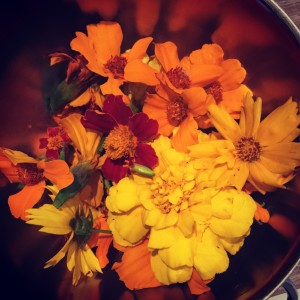Autumn has been a mellow affair. Trees are only starting to turn colour and drop leaves. Flowers continue to bloom and there is plenty of natural dye stuff still to be gathered. It’s time to get a basket and take a walk to find some dye stuff to try out now or over the winter.
I’m drying dahlias, marigolds, calendula and coreopsis from my garden. Acorns and walnuts are both good for dyeing as are sumac leaves, rhubarb roots, carrot tops, willow leaves and bark, chrysanthemums and pine cones. Not all plants will give you color and some that do–especially berries–are not colourfast. Don’t waste your time dyeing with blackberries or beets, for example, because the colour will fade quickly.
Lichen is also an option, but not all lichens give a dye. Sally is planning an in depth post on lichen dyeing so I will just give a few pointers on lichen gathering and preparation. Do your homework before you go out to identify lichens that give a dye. If you’re not sure there is the bleach test. If the lichen turns red when treated with a drop of bleach it should give colour for dyeing. Here is a helpful link on lichen dyeing.
Personally I’ve had no luck with lichen. Any pointers are appreciated!
As Autumn becomes winter there won’t be as much dye stuff around. However ivy berries and leaves might be worth a try along with mahonia berries. And there is always the humble onion skin. It gives a beautiful golden color and is simple to find and use. Other household items that give color include pomegranates and avocados.
For those of you who need help identifying plants I suggest a book that has pictures and descriptions of plants local to you. As Sally found out it’s properly identifying plants and trees is pretty important.
I use River Cottage’s Hedgerow book for identification. Books like the Ashford Book of Dyeing and Jill Goodwin’s A Dyers’ Manual give a lot of information on what colors certain plants give and whether they are color fast.
One other project for the budding natural dyer is to grow your own dye plants. I’ve started madder this year, which I need to re-pot into a larger container. Other flowers like dahlias, marigolds and coreopsis have all given loads of lovely yellows and gold colors this year. They’re all easy to grow and inexpensive. If you have space you might also try woad, indigo, St John’s Wort and safflower. It’s easy to find seeds online or from another natural dyer.



I just had my first natural dyeing class this evening, and we started by walking around the campus and collecting fallen leaves to use for dyeing. Another seasonally appropriate dyestuff! As far as plant identification goes, there are also a lot of apps out there that you can use on your smartphone. Some work just by snapping a picture of the plant in question.
What kinds of leaves? Did you do leaf dyeing? I’m going to check out the plant ID apps. My mom would love something like that.